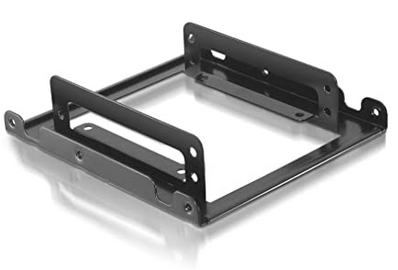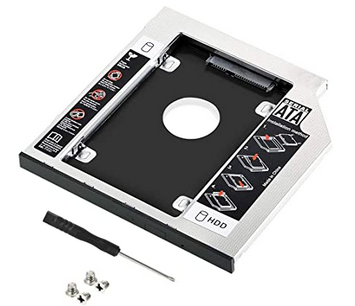Nas project - part 2
In part 1, I chose some hardware for my NAS, but before putting some money in the project, I wanted a lighter version, as cheap as possible.
I had the opportunity to get an old Optiplex from work, lets start with this.
Hardware Setup
I first try to find a solution to put 4 disks in the specific case without success.
As there is only one place for a 3,5” HDD, I found a sub case to install two 2,5”.

The solution to separate system and data disks was to use an hard drive adapter for the dvd drive place.

I chose to store the system on a Samsung SSD 870 Evo, 250 Go, and datas on two WD Blue 2,5” 5400 RPM, 2To
Is Proxmox a good choice ?
I wanted to use Proxmox for the main reason that it supports ZFS nativly and it is Debian based. After some questions on IRC, I realised that I didn’t need all the features it gives, and that it differs too much for a real Debian OS. The #debian channel on IRC can’t help, and #proxmox one is less active.
The solution came from IRC too.
Why don’t you use Debian 10 with a backport ?
- … because I don’t know what it is.
Debian backports allow you to use a package from next Debian release on the stable one.
Great news, current ZFS version in Debian Buster is 0.8 and in Debian Bullseye, it is 2.0 which comes with the ability to use zstd compression.
The only source of knowledge is experience
After a quick Debian install, the first service I setup is sshd, it should be easy to reach my server, lets test from outside.
My ISP router doesn’t gave me a router that had an important feature: the NAT Loopback. It allows you to reach a server from its public IP when source and destination are the same IP.
With my current ISP, the only workaround was to use alternativly public or private IP if I’m at home or not.
Two weeks later, and after some usual problems with my new ISP and line activation, I get my new router working and the ability to reach it with public IP from my local network.
Data managment
Data on a mirrored storage is reliable only in case of physical problem on the pool. To be completely safe, I still need to replicate that data outside of home. Not all the data needs replication, nor sync, lets define how to manage all kind of data.
| Type | Size | Sensitivity | Incremental backup | Replication | Daily access | Access type |
|---|---|---|---|---|---|---|
| Archives: pictures, videos | + | ++ | No | Yes | No | mount |
| Administrative docs | - | ++ | Yes | Yes | Yes | sync |
| Systems and homes backups | ++ | + | Yes | Yes | No | mount-sync |
| Phone Pictures, contacts | - | - | No | No | No | sync |
| Others | ++ | - | No | No | No | mount |
The solution for data which needs Replication is syncthing.
Backups will be done with borgbackup.
Zpool creation
Let’s create the pool
$ zpool create -f -o ashift=12 \
-O acltype=posixacl \
-O compression=zstd \
-O relatime=on \
-O xattr=sa \
-O dnodesize=legacy \
-O normalization=formD \
-O mountpoint=none \
-O canmount=off \
-O devices=off \
dpool /dev/sdb /dev/sdc
And some datasets
$ zfs create –o mountpoint=/data/zfs/backups dpool/backups
$ zfs create –o mountpoint=/data/zfs/sync dpool/sync
$ zfs create –o mountpoint=/data/zfs/vms dpool/vms
$ zfs create –o mountpoint=/data/zfs/docker dpool/docker
After copying some data
$ zfs list -o name,used,compressratio,logicalused,avail
NAME USED RATIO LUSED AVAIL
dpool 404G 1.06x 427G 1.36T
dpool/backups 275G 1.00x 275G 1.36T
dpool/docker 176M 2.66x 415M 1.36T
dpool/sync 723M 1.07x 765M 1.36T
dpool/vms 96K 1.00x 42K 1.36T
[...]